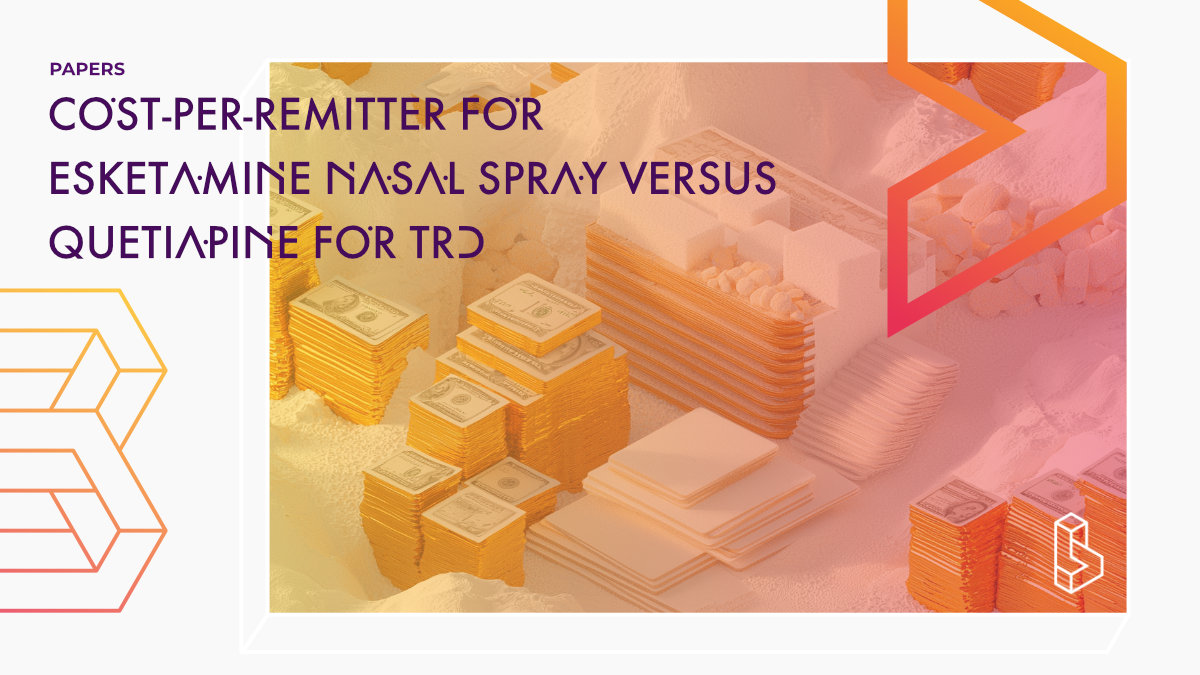This economic analysis comparing esketamine nasal spray (plus oral antidepressant) versus quetiapine extended release (plus oral antidepressant) for treatment-resistant depression (TRD) found esketamine achieved higher remission rates at 32 weeks (50% vs 33%) and lower cost-per-remitter in both commercial ($3,102 lower) and Medicaid ($456 lower) settings, with even greater cost savings in scenarios where non-responders received transcranial magnetic stimulation.
Abstract Cost-per-remitter for esketamine nasal spray versus quetiapine for TRD
“Aim: Estimate the cost-per-remitter with esketamine nasal spray plus an oral antidepressant (ESK NS + OAD) versus quetiapine extended release plus an oral antidepressant (QTP XR + OAD) among adults with treatment-resistant depression (TRD).
Materials & methods: An Excel-based model was developed to estimate the cost-per-remitter for ESK NS + OAD and QTP XR + OAD from the perspective of a US commercial insurance plan and Medicaid. Remission and response rates were estimated in 4-week intervals over 32 weeks using data from the ESCAPE-TRD phase IIIb clinical trial comparing ESK NS + OAD versus QTP XR + OAD in adults with TRD. Direct healthcare costs were sourced from health economic literature and the RED BOOK® drug pricing database. Indirect costs were derived from a separate analysis of ESCAPE-TRD using the Work Productivity and Activity Impairment: Depression questionnaire. Adults not remitting/responding either stayed on current treatment or discontinued current treatment and initiated either augmented therapy with antipsychotics or repetitive transcranial magnetic stimulation. In a scenario analysis, all individuals who did not achieve response and discontinued treatment initiated repetitive transcranial magnetic stimulation.
Results: The remission rate at 32 weeks was 50% for adults receiving ESK NS + OAD and 33% for adults receiving QTP XR + OAD. The cost-per-remitter for ESK NS + OAD compared with QTP XR + OAD was $3102.17 lower in the commercial setting and $456.12 lower in the Medicaid setting. Under the scenario analysis, the cost-per-remitter for ESK NS + OAD compared with QTP XR + OAD was $15,133.66 lower in the commercial setting and $12,487.62 lower in the Medicaid setting.
Conclusion: The findings suggest that ESK NS + OAD is a cost-effective treatment for adults with TRD compared with QTP XR + OAD in the commercial and Medicaid settings.“
Authors: Kristin Clemens, Amanda Teeple, Benoit Rive, Noam Kirson, Urvi Desai, Jason Doran, Diab Eid, Alice Qu, Hannah Bowrey & Kruti Joshi
Summary of Cost-per-remitter for esketamine nasal spray versus quetiapine for TRD
Major depressive disorder (MDD) affects a significant portion of the adult population in the United States, with over 8% experiencing a major depressive episode each year. Treatment-resistant depression (TRD) is a particularly severe form of MDD, defined by the failure to respond to at least two antidepressants of adequate dose and duration. Approximately 31% of individuals treated for depression fall into this category, and they face greater clinical challenges, higher healthcare use, and a reduced quality of life compared to those with non-resistant depression.
Standard options for managing TRD include oral antidepressants, augmentation with antipsychotic medications, and brain stimulation therapies such as electroconvulsive therapy and repetitive transcranial magnetic stimulation (rTMS). However, augmentation with antipsychotics like quetiapine is often associated with poor adherence and adverse effects, such as weight gain and metabolic issues, which can limit its effectiveness. Esketamine nasal spray (ESK NS), administered under clinical supervision, has emerged as a novel treatment for TRD, showing promising clinical efficacy in earlier trials. The ESCAPE-TRD Phase IIIb trial compared ESK NS combined with an oral antidepressant (OAD) to quetiapine extended release (QTP XR) plus an OAD. While that trial established clinical superiority of esketamine in some outcomes, the present study by Clemens and colleagues seeks to quantify the economic implications, particularly the cost-per-remitter.
Methods
Modelling Framework
An Excel-based economic model was developed to estimate the cost-per-remitter over a 32-week period for ESK NS + OAD versus QTP XR + OAD. A remitter was defined as an individual achieving a Montgomery–Åsberg Depression Rating Scale (MADRS) score of 10 or less. The model included both direct medical costs (e.g. drugs, administration, outpatient care) and indirect costs related to work productivity, such as absenteeism and presenteeism. Cost data were drawn from published literature and databases including the RED BOOK drug pricing resource.
Find this paper
Cost-per-remitter for esketamine nasal spray versus quetiapine for treatment-resistant depression
https://doi.org/10.57264/cer-2024-0092
Open Access | Google Scholar | Backup | 🕊
Cite this paper (APA)
Clemens, K., Teeple, A., Rive, B., Kirson, N., Desai, U., Doran, J., ... & Joshi, K. (2025). Cost-per-remitter for esketamine nasal spray versus quetiapine for treatment-resistant depression. Journal of Comparative Effectiveness Research, (0), e240092.
Study details
Compounds studied
Placebo
Ketamine
Topics studied
Economics
Depression
Treatment-Resistant Depression
Study characteristics
Participants
638
Humans

